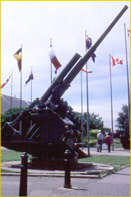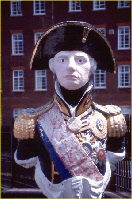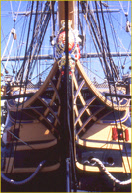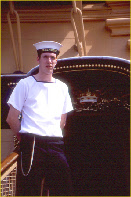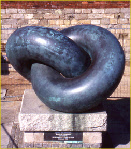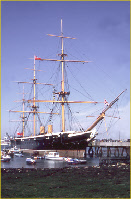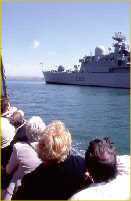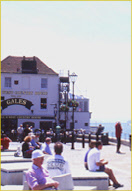Derek Tickner
© 2016 Derek Tickner

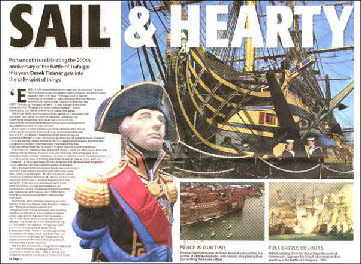
Portsmouth is celebrating the 200th anniversary of the Battle of Trafalgar this year. Derek Tickner gets into the salty spirit of things.
“England expects that every man will do his duty.” As the British ships-
With the 200th anniversary of the Battle of Trafalgar this October, the naval city
of Portsmouth, 100 km to the south-west of London, will be at the centre of the nationwide
events celebrating all things nautical in general, and Nelson’s victory in particular.
It comes under the banner of SeaBritain 2005. Some of the attractions in June and
July include the International Fleet Review by the Queen (featuring ships from forty
navies including HMAS Anzac), an action-
Portsmouth Harbour has sheltered ships of war for two thousand years, from the galleys
of the Roman Empire to today’s missile firing frigates. The flagship of the historic
vessels on display is HMS Victory. Commissioned in 1778, she is the only surviving
example of one of “the wooden walls of England.” A first-
I went on a tour around this meticulously restored ship. The lower decks are cramped and dark, even with the gun ports open. At 193cm I am the same height as Captain Thomas Hardy, of “Kiss me Hardy” fame. The only place he could stand upright was beneath the skylight. The cannons dominate each deck, between them are the mess tables and hammocks where the 800 sailors and marines ate, slept and entertained each other with rollicking shanties and other seamanlike pursuits.
Our guide, Bob, relishes regaling us with details of the hardships of a Georgian
sailor’s life. “Floggings were ordered for comparatively minor offences, like spitting
tobacco on the deck. The culprit would be given a length of rope and told to make
a cat-
“And see how the cannons are secured to the bulkheads by ropes? If one broke free during a storm, it was literally a ‘loose cannon’.” Bob’s on an etymological roll. “A ton of metal smashing everything in its path with each roll of the ship. Resolute teamwork was needed to make it secure.”
We’re led down to the orlop in the bowels of the ship, where the decking is painted a gruesome shade of red. “This is where the surgeons worked, hacking off shattered limbs and extracting the large jagged splinters that were sent flying like shrapnel when a cannon ball smashed through oak,” Bob explains. “The red paint is so the deck didn’t show the blood.”
At the height of the Battle of Trafalgar Nelson was hit by a sharp shooter’s musket ball. Bob ushers us through the gloom to the most sacred shrine of the Royal Navy, the bulkhead where Nelson was propped, mortally wounded. He died soon after hearing that victory was assured.
The triumph at Trafalgar was not only good news for England but for Australia too. If Nelson had lost, the French and Spanish fleet would have sailed up the English Channel and carried Napoleon’s army across from France to invade England. The fledgling colonies on the other side of the world would have been in dire peril, as they were dependent on ongoing supplies and migrants from the Mother Country.
With England conquered, France could have taken control of the British Empire. A French army may have sailed to Australia and a situation akin to Canada would have occurred, with European troops fighting for the country. But victory at Trafalgar ensured Britannia ruled the waves throughout the nineteenth century, allowing the settlement of Australia to proceed unhindered.
Portsmouth has another, less speculative, connection with Australia: the First Fleet sailed from its harbour on May 13, 1787. There’s a bronze inscription that celebrates the birth of modern Australia by the Sally Port, the gateway in the defensive harbour walls.
For centuries soldiers, sailors (including Nelson), settlers and convicts have left England’s shores through this portal, many for the last time. Alongside is a sculpture by John Robinson, Bonds of Friendship, consisting of two massive chain links that symbolises the ties between Portsmouth and Sydney and the close relationship between England and Australia. There’s an identical sculpture at the other end of the imaginary chain at Circular Quay.
HMS Victory is dry-
As you approach the Dockyard you see the sleek, black lines of the revolutionary
HMS Warrior. Launched in 1860, she was Britain's first iron-
Portsmouth has been a prime target for enemy attack, from centuries of raids by the traditional foe the French to the Blitz from Hitler’s Luftwaffe. As a result, Portsmouth and its seaside suburb of Southsea are ringed by fortifications, ancient and modern.
In 1545, on the battlements of Southsea Castle, Henry VIII stood and watched in dismay as the Mary Rose, the pride of the Tudor fleet, rolled over and swiftly sank as she engaged several French raiders. The Mary Rose was raised in 1982 and her remains can be viewed at the Mary Rose Exhibition in the Dockyard, along with thousands of the artifacts recovered from her.
The cache of longbows discovered on board enabled researchers to examine this powerful weapon and confirm its armour penetrating qualities. Little wonder that the French cut off the two string pulling fingers of any English bowmen they captured. Which is the probable origin of the two fingered salute: before battle, the English archers would wave those two fingers at the French, accompanied by shouts along the lines of, “We’ve got our bows and fingers, so you’re going to cop it. We’d advise you to go home.”
Behind Southsea Castle, the D-
Further along Southsea’s pebbly beach, Lumps Fort now slumbers peacefully, its thick walls sheltering a charming rose garden. In 1940 there was a more martial air as the Royal Marine Commandos, dubbed the Cockleshell Heroes, trained here before launching daring raids in canoes on German shipping. Few returned, and those captured were shot as spies.
Portsmouth isn’t all about history, it’s still very much an active naval base today. A cruise around the harbour takes you abeam of whichever of the Royal Navy’s ships is in port. Wave at the sailors, they’ll give you a cheeky wave back.
The Gunwharf Quays and Spinnaker Tower are the main attractions of the £38 million ($92m) ‘Renaissance of Portsmouth Harbour’ project. The Gunwharf, located on the waterfront with views across the busy harbour, is a mix of restored warehouses and sympathetically designed new shops, cafés, bars and a cinema. Street theatre, musicians, buskers, markets and exhibitions give a vibrancy to the area.
Spinnaker Tower is due for completion later this year. The promotional blurb promises “…a contemporary, national icon…with two large white sweeping arcs that give the tower its distinctive spinnaker sail design…soaring 170 metres above Portsmouth Harbour, offering visitors spectacular views.”
Being a tourist is thirsty work, and in a navy town you’re never far from a pub.
In Old Portsmouth you’re spoilt for choice when it comes to historic hostelries that
have heaved and hoed to generations of drunken sailors. My favourite is The Still
and West by the narrow port’s mouth (hence the name of the city, non-
What else to eat in an English seaside city than fish and chips, washed down with
a pint of the local ale? Hampshire brewer Gales Ales makes a marvelous selection
of beers, and Horndean Special Bitter is their finest. It’s a full-
The beer’s served warm, of course: England expects that every Aussie will do his duty and drink a pint.
